| Tamales | ||
|
Today Doņa Martha
made three kinds of tamales -- pork in a chile colorado sauce, chicken,
and sweet with pineapple. |
||
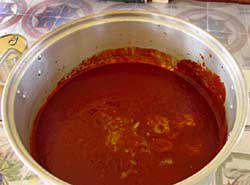 |
She made the chile colorado sauce early in the morning before I arrived to take pictures, but you can look here: Chile Colorado. The chicken was boiled with the usual quarter of an onion and a garlic clove. After it was well cooked, it was allowed to cool, then skinned and the meat shredded by hand. The chicken tamales are not spicy. Many (most?) cooks use a pork shoulder or butt for making tamales, but on this day Doņa Martha choose a pig's head. I have seen them for sale in the markets and wondered what they were used for. Now I know. The head was boiled (covered) until the meat was falling off the bones. Then began the process of dismem-bering the head, cutting away the fat and gristle, and then shredding the meat. It is a long and tedious process which began with the removal of the jaw bone and tongue. |
 |
 |
 |
|
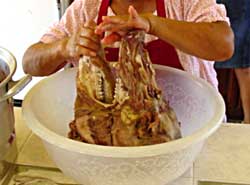 |
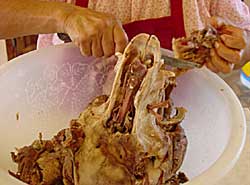 |
|
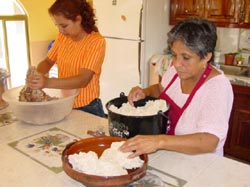 |
After a while, the meat shredding task was passed to daughter-in-law, Rayo, so Martha could begin the preparation of the masa. In the small bowl, she will prepare the masa for the sweet tamales. The large bowl is for the pork and chicken. She adds meat stock to both and allows it to stand until it is adsorbed before kneading the masa. The masa was bought from the neighborhood tortilla maker. See Making Tortillas to see how masa is made. A couple of the grandkids are playing dentist with the pig's jaw bone. I had no idea pigs had so many teeth, and so many different kinds of teeth. Educational for me and the kids. |
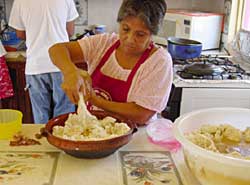 |
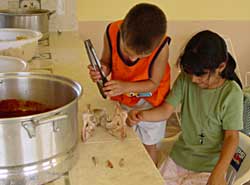 |
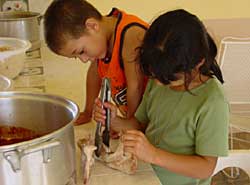 |
|
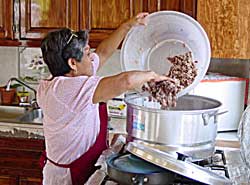 |
After bringing the chile sauce to a simmer, the pork is added and simmered to mingle the flavors. Doņa Martha begins to knead the moistened masa until it is smooth and the stock is fully absorbed. The fillings are ready, the masa is ready, so the time has come to assemble the tamales. Rayo
begins by spreading a thin layer of masa over the bottom two-thirds of a
corn shuck that has soaked in water for a couple of hours. |
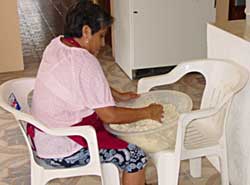 |
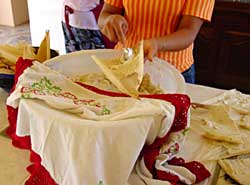 |
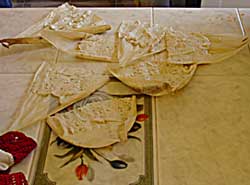 |
|
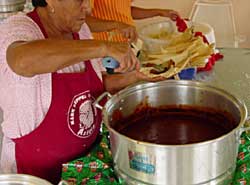 |
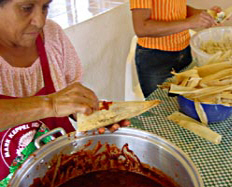 |
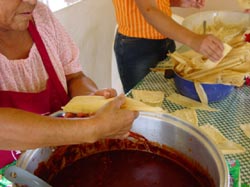 |
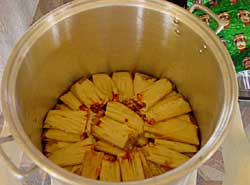 |
The tamales are carefully stacked in the steamer. The broth produced by boiling the head is used for the liquid in the steamer. Chunks of pineapple and a lot of sugar are added and kneaded into the masa for the sweet tamales. The masa for the meat tamales was soft, this sweet masa is much more runny. |
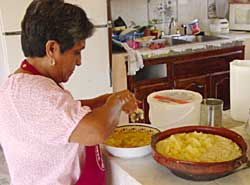 |
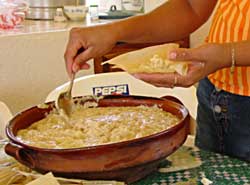 |
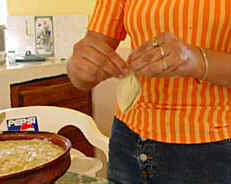 |
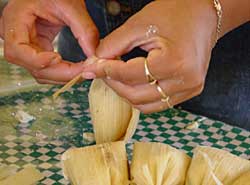 |
|
Rayo spoons a bit of the soupy masa into the center of a corn shuck. |
Then folds it into a little pouch and ties it shut with a sliver of shuck provided by me between camera snaps. These will be steamed with plain water. |
|
 |
Daughter Martha comes to start the clean up while the last of the sweet tamales are being readied. Earlier, 8-year old Iris joined her mother, aunt Rayo and grand-mother as cooking skills are passed from generation to generation. Doņa Martha says this is how she learned to cook half a century ago. There was a lot of story telling and laughing during the long day. And there was a varying parade of watchers who came and went through the 8 hours of kitchen activity. Tamales don't happen quickly. The chicken and the sweet tamales were set to steam on the kitchen stove. The pot of pork tamales was too large, so it went to the charcoal grill on the patio. An electric fan does wonders when the charcoal needs a little boost. An hour later, the tamales were done. Gonzalo and Gabriel lift the pot off, and the feasting begins. |
 |
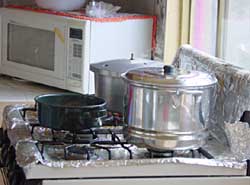 |
 |
|
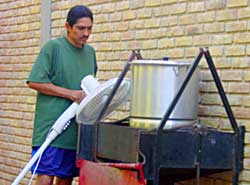 |
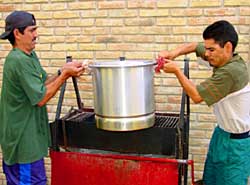 |
|
 |
Armando is only four, but already he is a camera hog -- and he does pretty well on sweet tamales, too. Copi waits at the door ready for any handout that might come her way. She lucked out a lot today. |
 |
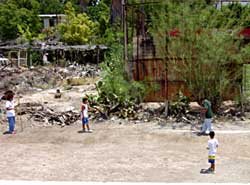 |
Meanwhile, after the older boys cleaned the vacant lot next door, they enlisted the aid of uncle Gonzalo to help them lay out a soccer field. This is the lot we used for storing building materials while we were building their homes, which we now call Las Casas. |
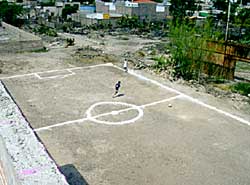 |
|
Tamales is the plural of tamal. Tamale is not a Spanish word; it is an English corruption of tamal. An UpDate: This story was photographed in 2003. Now, Fall 2010, Doņa Martha has begun a tamal business in her home to raise money to buy a grave marker for her son who died recently. She makes them on Thursday to sell that night and over the weekend. I buy six each Thursday evening -- three for supper and three to be added to my signature veggie soup on Friday. Tamal veggie soup is wonderful. If you wish to write to Doņa Martha, you may send an e-mail to martha@rollybrook.com |
||
| Cooking Directory | ||